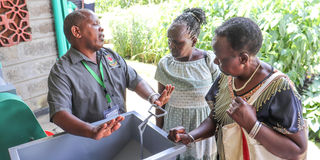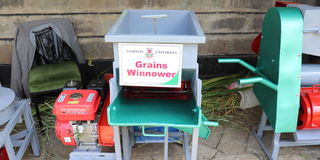Egerton University invents multipurpose grain winnower

Dr. Musa Njue, an Agricultural Engineer at Egerton University, explains how the winnower works during the Nakuru ASK show.
For generations, cereal farmers have relied on the age-old technique of winnowing to separate chaff from their harvest taking days and even weeks to complete.
This has always been done by carefully throwing the grain into the air in the direction of the wind. The lighter chaff is blown away, while the heavier grain settles back onto the winnowing tray, locally known as 'uteo'.
The activity requires arm strength and stamina, but most importantly, one has to wait for windy days for the winnowing to happen smoothly, increasing the risks of postharvest loss.
But an expert notes that modern innovations are offering better alternatives- like the grain winnower.
Dr. Musa Njue, an Agricultural Engineer at Egerton University, explains the revolutionary impact of the winnower.
“This machine efficiently cleans all types of grains, significantly speeding up the process for farmers,” he states. “It eliminates the backbreaking effort associated with traditional winnowing methods, effectively removing the work from this essential task.”

The grains winnower created by Egerton University in Nakuru.
The machine has several basic components; a hopper (chamber holding the grain), engine, blower/ fan, grain collector, dust outlet, and wheels that help with portability.
To use the machine, start the engine and let it warm up. Next, pour your grain into the hopper using the control system to adjust how much grain flows through for cleaning.
As the machine operates, keep an eye on both ends: one for chaff and the other for clean grain. Adjust the settings until you achieve the ideal separation of chaff from the cleaned grain.
The machine can run continuously for about six hours and then be given a break.
The lead engineer in the project also notes that this tech has been able to increase the productivity of individuals, and its capacity is determined by the amount of chaff contamination in the grain.
“The machine dramatically increases an individual's productivity,” Dr. Njue explains. “If one person traditionally winnows three bags of grain in a week, this machine can clean the same amount in less than an hour while greatly reducing postharvest losses.”
The winnower can clean 1000kg of wheat in one hour and 1.5 tons of maize which has less chaff, at the same time too.
However, beans, which have more trash, are limited to cleaning just two bags per hour.
The machine costs Sh. 65,000 and has a decade lifespan with continuous servicing.
While there has been a never-ending debate about machinery replacing human labour, Dr. Njue argues that when producing food to sell, keeping costs low is important.
“Using machines can lower costs, while manual labour costs more,” he notes.
While the winnower may be a bit expensive to own in an individual capacity, the expert notes that cooperatives and youth groups can purchase one and rent it out thus, creating job opportunities and increasing supplemental income.

